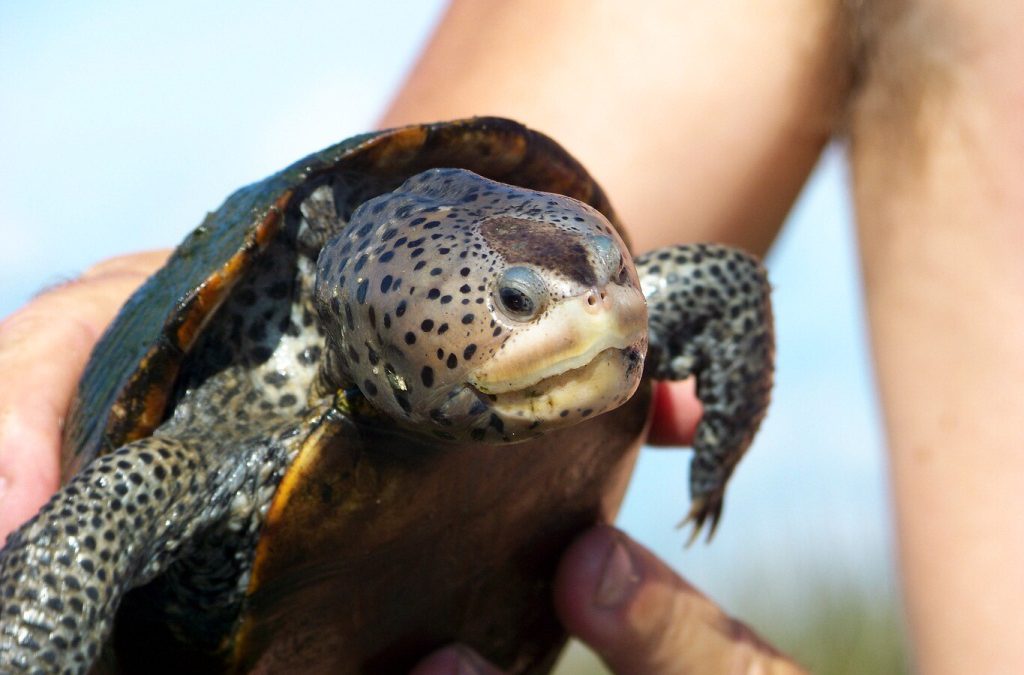
by Rick O'Connor | Apr 1, 2022
In December of 2021 the Florida Fish and Wildlife Conservation Commission (FWC) passed new regulations concerning the diamondback terrapin. One will make it illegal to possess a terrapin without a permit beginning March 1, 2022. The other will impact recreational crab trap design in early 2023. A number of people have begun to ask questions ab
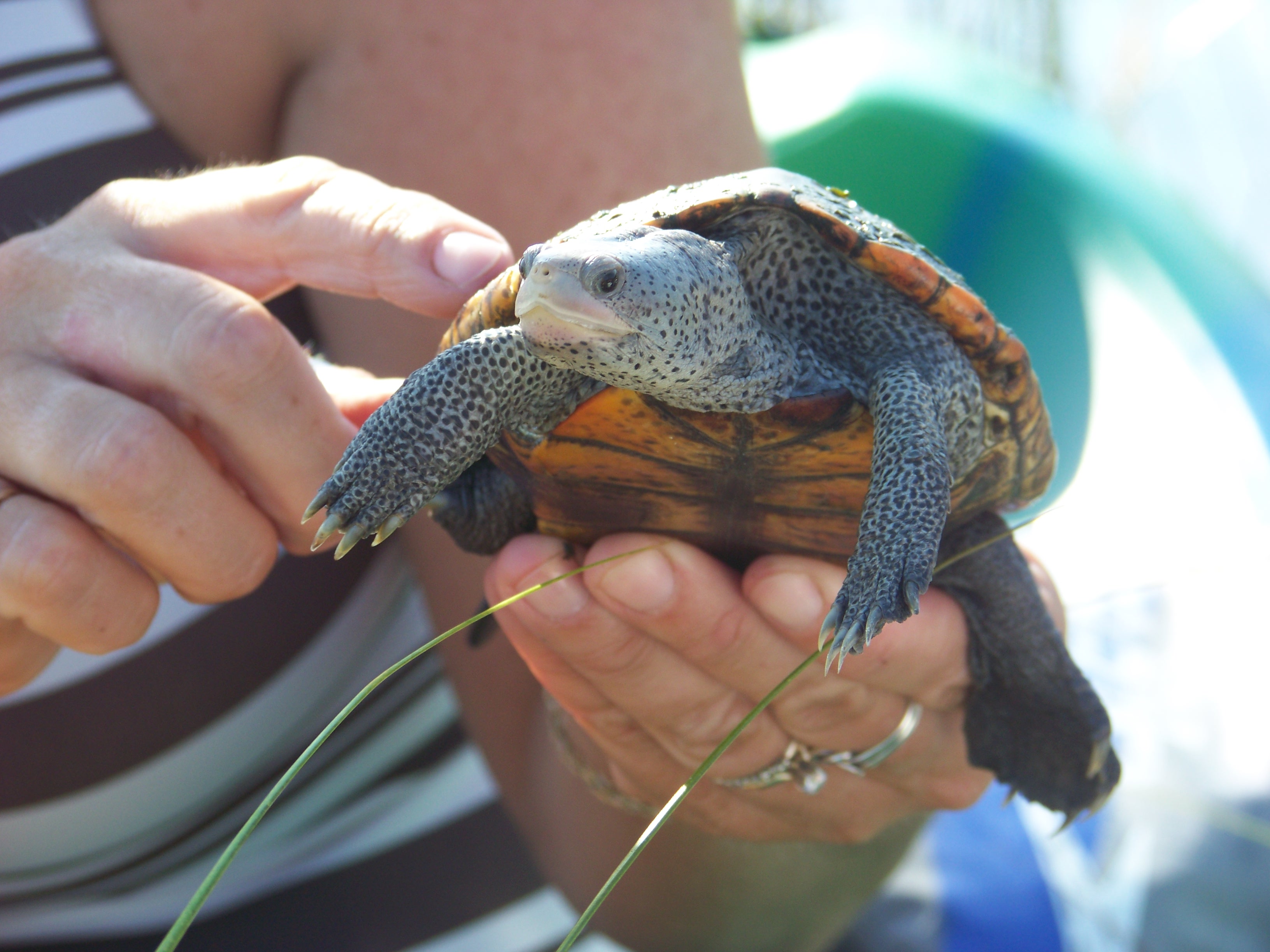
The diamond in the marsh. The diamondback terrapin.
Photo: Molly O’Connor
ut this new ruling so, we will explain it.
WHAT IS A DIAMONDBACK TERRAPIN?
We will start there. Most Floridians have never heard of this animal, and if they have, they know it from the Chesapeake Bay area. Diamondback terrapins are turtles in the Family Emydidae. This family includes many of the pond turtles Floridians are familiar with – cooters, sliders, red-belly, and others. The big difference between terrapins and pond turtles is the coloration of their skin, and their preference for brackish water – they like estuaries over ponds and lakes. They do have lachrymal glands in their eyes to help excrete salt from water, but they are not as efficient as those of sea turtles so, they cannot live in sea water for more than about a month – it is the bays and bayous they like to call home.
There are seven recognized subspecies which range from Cape Cod MA., to Brownsville TX. Five of them are found in Florida and three are only found in Florida. But few Floridians have ever heard of them and even fewer have seen one. Their cousins the pond turtles are quite common. We see their heads in ponds and lakes, several of them basking on logs near shore of ponds, lakes, and rivers, and frequently see dead ones along our highways. We don’t see terrapins. We do not see their heads in the marsh, basking on logs, or dead carcasses along our coastal highways. Again, this is an unknown turtle to us.
WHY ARE THERE NEW REGULATIONS ON A TURTLE MANY HAVE NEVER SEEN?
The question sort of explains the answer – we do not see them – their population in our state may deem some action by the FWC. In the Chesapeake region they are quite common, and people see them frequently. It is the mascot of the University of Maryland. Along the roads to the barrier islands in Georgia hundreds of terrapins can be found trying to nest and many are hit by cars. In most of these mid-Atlantic states there is some form of protection for them. They either list them as threatened or a species of concern. One state has it listed as endangered. Again, these are states where encounters are much more common.
Florida has a rich diversity of turtles, maybe the richest in the country, and we have been the target for turtle harvest. Turtles are sought after for food and as pets. The harvest of some species has been heavy and FWC has listed them as “no take”. For a variety of reasons, harvest being one of them, Alligator Snapping Turtles (Macrochelys temminckii), the Suwannee Cooter (Pseudemys suwanniensis), and the Barbour’s Map Turtle (Graptemys barbouri) are illegal to possess without a permit. This includes their eggs. Because other species look very similar to these, they have also been added to the no-take list. This would include all species of cooters and snapping turtles, the Escambia Map Turtle (Graptemys ernsti) and the Striped Mud Turtle (Kinosternon baurii) – which is a small riverine turtle that resembles a small snapping turtle. Note: the regulation on the striped mud turtle is for the lower Florida Keys only. You could take diamondback terrapins but only one and you could have no more than two in your possession. You could not possess their eggs. But with the 2021 ruling – this has changed.
As mentioned, terrapin encounters are rare in our state. There has been concern about their population status here. I got involved with them in 2005 primarily to answer the question “Do terrapins even exist in the Florida panhandle?”. The answer is yes, they do. Since 2005 myself, and trained volunteers, have conducted 859 surveys searching for them between Escambia and Franklin counties. We have encountered terrapins, or terrapin sign (tracks, shells, depredated nests) 215 of those – 25% of the surveys; most of those encounters were terrapin sign – they are hard creatures to find. Because of the low encounter rate across the state, it is believed that the populations here are low and in need for conservation measures.
Then comes the crab traps…
Researchers with the Diamondback Terrapin Working Group have identified several stressors to terrapin populations. Loss of habitat, depredated nests by predators (particularly the raccoon), road mortality, and… crab traps. Terrapins feed primarily on shellfish but will eat other things if given the opportunity. They do have a tendency to enter crab traps. Though they feed on small juvenile crabs it is the bait we think they are after in this scenario. Once in, like blue crabs, they find it hard to escape. Unlike blue crabs, turtles have lungs, and the terrapins eventually drown. In the Chesapeake Bay region blue crabs are ”king” – a major commercial and recreational fishery. Terrapins entering crab traps means crabs are not. There have been as many as 40 dead terrapins found in one trap. This was a major concern for all. Dr. Roger Woods of the Wetlands Institute in New Jersey began working on a device that would keep terrapins out but allow blue crabs in. Data shows that in most cases, the larger females are the ones entering and the smaller males would follow. If you could keep the female out it was believed that most males would not enter. So, the device was designed to keep the large females out. A 6×2” rectangle seemed to work best. Field studies showed that these By-Catch Reduction Devices (BRDs) kept 80-90% of the terrapins out and did not significantly impact the crab catch. We had a design that seemed to work.
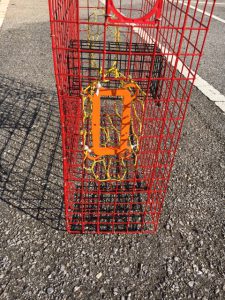
This orange plastic rectangle is a Bycatch Reduction Device (BRD) used to keep terrapins out of crab traps – but not crabs.
Photo: Rick O’Connor
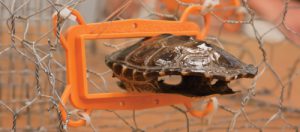
BRDs are designed to keep terrapins out but allow crabs to enter.
Photo: Virginia Sea Grant
These BRDs have been required in the Mid-Atlantic states for a few years now. With the concern in Florida populations, it is now coming to Florida. By March 1, 2023, all recreational crab traps in Florida will be required to have a fixed funnel size no larger than 6×2”. Either the funnel must be this size, or you can attach one of the plastic orange BRDs to the opening (see photo). Currently bait and tackle shops do not have the BRDs but will be acquiring over the next year. FWC will be working on providing sources between now and March of 2023. If you are in the Pensacola area you can contact me, I have a case of them in my office.
As far as having one on your possession – it is now a no-take species. This rule began March 1, 2022. If you have had a terrapin in your possession you can apply for a no-cost permit to keep it (visit the FWC link below to obtain information on applying for this permit). If you are an education facility that houses terrapins for educational purposes – the same, you can apply for a no-cost education permit to keep your terrapins. You must have this permit by May 31, 2022.
If you have any questions concerning this ruling or how to comply with it, you can contact FWC or your county Sea Grant Extension Agent. The FWC link for more information on this, and other turtle regulations, can be found at https://myfwc.com/wildlifehabitats/wildlife/freshwater-turtles/?redirect=freshwaterturtles&utm_content=&utm_medium=email&utm_name=&utm_source=govdelivery&utm_term=campaign.
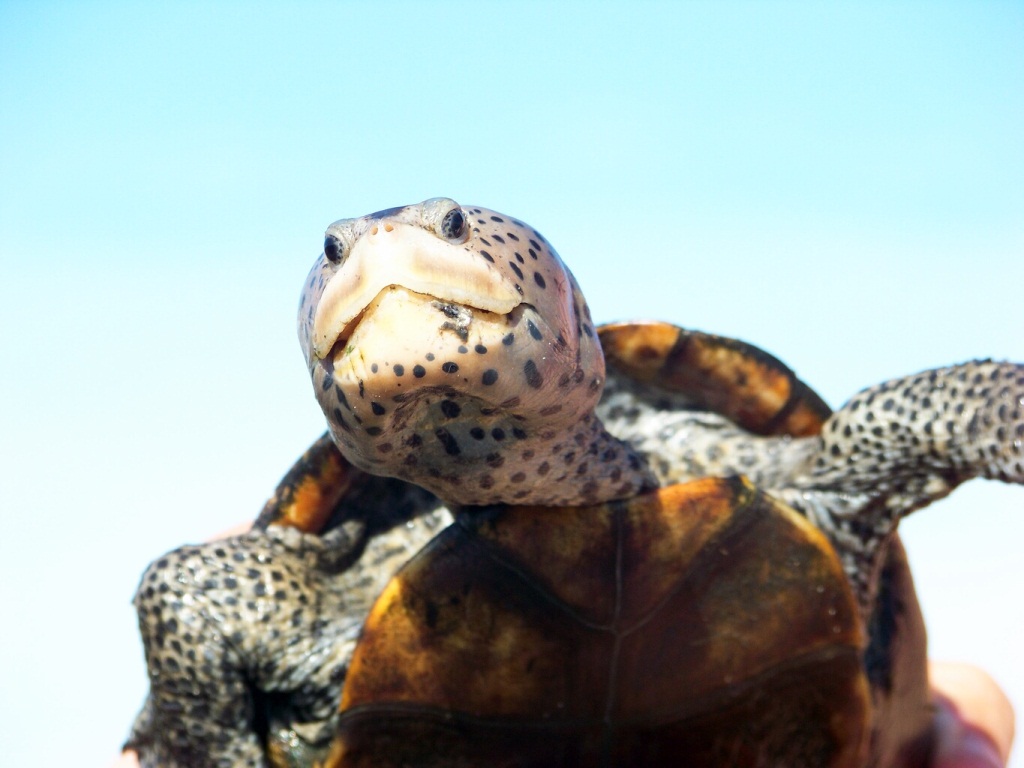
by Rick O'Connor | Mar 11, 2022
Let’s begin by stating what a diamondback terrapin is. I have found many Floridians are not familiar with the animal. It is a turtle. A turtle in the family Emydidae which includes the pond turtles, such as cooters and sliders. The big difference between terrapins and the other emydid turtles is their preference for salt water. They are not marine turtles but rather estuarine – they like brackish water.
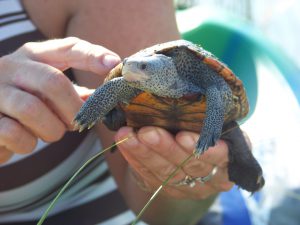
The diamond in the marsh. The diamondback terrapin.
Photo: Molly O’Connor
Their haunt are the salt marshes and mangroves of the state. Their range extends from Massachusetts down the east coast and covering all of the Gulf of Mexico over to Brownsville Texas. There are seven subspecies of the animal within that range. Five of those live in Florida and three only live in Florida. They are more abundant, and well known, in the Chesapeake Bay area where they are the mascot of the University of Maryland. In Florida they seem to be more secretive and hidden. Encounters with them are rare and there has been concern about their status for years. Though researchers are not 100% sure on their population size, it was felt that more conservation measures were needed.
Ten years ago, the issue with all turtles in the state was the illegal harvest for the food trade. All sorts of species were being captured and sent to markets overseas. The Florida Fish and Wildlife Conservation Commission (FWC) stepped in and set possession quotas on many species of Florida turtles. For terrapins, the number was two. For some, like the Suwannee Cooter, there was a no possession rule.
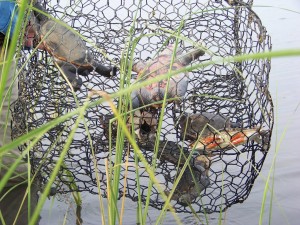
Drowned terrapins in a derelict crab trap in the Florida panhandle. (photo: Molly O’Connor)
There has also been concern with incidental capture of terrapins in crab traps. These turtles have been known to swim into the traps and drown. In the Chesapeake Bay area, they have found as many as 40 dead turtles in one trap. Not only is this bad for the turtles, but it is also bad for the crab fisherman because high numbers of dead turtles in the trap means no crabs. Studies began to develop some sort of excluder device that would keep terrapins out, but allow crabs in. Dr. Roger Wood developed a rectangle shaped wire excluder now called a By-Catch Reduction Device (BRD) that reduced the terrapin capture by 80-90% but had no significant effect on the crab catch. That was what they were looking for. This BRD has been required on crab traps up there for years.
What about Florida?
Studies using the BRD were also conducted here with the same results, but the BRD was not required. Incidental capture in crab traps does occur here but not to the extent it was happening in the Chesapeake and FWC wanted to hold off for more science before enacting the rule. BRDs were available for those who wanted them, but not required. This past December (2021) that changed.

This orange plastic rectangle is a Bycatch Reduction Device (BRD) used to keep terrapins out of crab traps – but not crabs.
Photo: Rick O’Connor
In recent years there has been another issue with harvesting terrapins for the pet trade. With this, and other conservation concerns for this turtle, FWC developed a new rule for terrapins at their December 2021 meeting.
- The possession limit for terrapins has dropped from 2 to 0 – there is a no-take rule for this animal beginning March 1, 2022. Collection for scientific research will still be allowed with a valid collecting permit from the FWC. Those who currently have two or less terrapins in their possession as pets may keep them but must obtain a no cost personal possession permit to do so by May 31, 2022. Those who have terrapins within an education center may keep them but must obtain a no cost exhibit permit by May 31, 2022.
- Recreational crab traps will require the BRD device by March 1, 2023. You have a year. Those in the Pensacola area can contact me for these. I have a case of them I am willing to provide to the public.
Again, studies have shown that these BRDs do not significantly impact the crab catch. Crabs can turn sideways and still enter the traps. But reducing incidental capture of terrapins will hopefully increase their numbers in our state. For information on how to obtain the needed permits visit FWC.
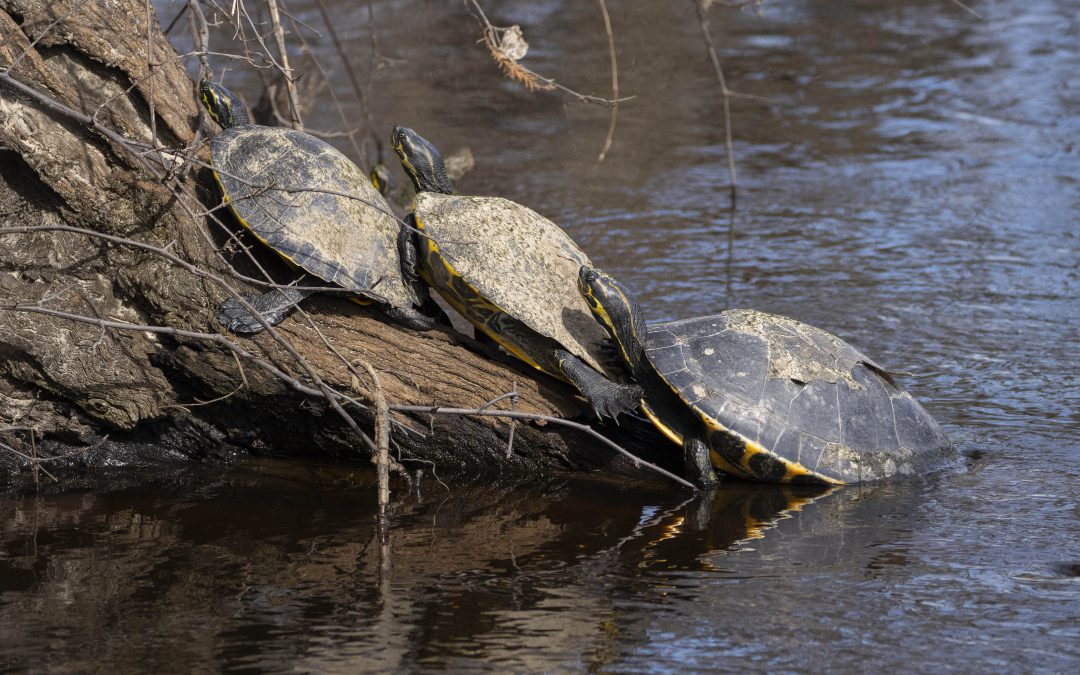
by Erik Lovestrand | Jun 3, 2021
Identifying North Florida river turtles can be quite challenging, given the fact that several species are collectively referred to as “streak-ed heads” by many people. Although you will not find this term in the scientific naming conventions, it is actually an apt description for many turtles in the Southeast that have dark skin with thin, yellow pinstripes on their head and neck. North Florida has at least half a dozen species that fall into this general grouping. They include the Suwannee cooter, river cooter, Florida cooter, chicken turtle, yellow-bellied slider and a couple of map turtles. We even have a disjunct population of Florida red-bellied turtles on the Apalachicola River that are isolated from the main group, which is restricted to peninsular Florida and extreme Southeastern Georgia. Overall, we have about 25 species of turtles in Florida.
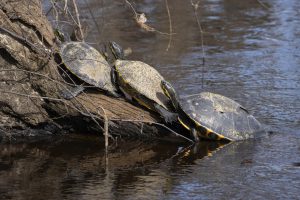
Suwannee cooters at Lafayette Blue Springs, Lafayette County, Florida, 2021.
FWC Photo by Andy Wraithmell
As you might guess, the key to accurate river turtle identification lies in the details and the details can be tough to see. Most basking turtles tend to tumble off their logs into the water long before you are close enough to scrutinize their features. However, a few tips and tricks may improve your chances when going afield. A good pair of binoculars and a reptile field guide are must-haves. You need to be able to see if the yellow on the side of the head is a wide splash (as on the yellow-bellied slider), or a series of thin lines (as on various cooters). If the top shell (carapace) is very dark and the bottom shell (plastron) shows orange color, you might have a red-belly or Suwannee cooter (higher dome on red-belly, relatively). Two of our native species have what are referred to as “striped breeches”. When viewed from the rear, the stripes on the hind legs are vertically oriented on the yellow-bellied slider and the Florida chicken turtle. The chicken turtle is distinguished by a relatively narrower head and a wide, yellow stripe on the front legs. Separating the various cooter species gets a little trickier. You need to use characteristics like the pattern on the plastron, the occurrence of “hairpin-shaped” stripes on the head, or the pattern of lines on particular carapace scutes.
So how do you get those clues in the wild? A good telephoto lens may work if you are fortunate enough to own one. This will give you the opportunity to study detailed features at your leisure. Otherwise, you may not be able to identify a turtle to the species level. Getting close to a wary turtle is not easy. However, on busy stretches of our waterways, where wildlife are desensitized to people and boats, turtles generally have a wider comfort zone. Especially if you are in a canoe or kayak and minimize your movement and sound as you glide in for a better view. Lastly, go looking on a bright sunny day and your opportunities will vastly increase as turtles climb out of the water onto logs to soak up some of that good old Florida sunshine. One species that you should have no trouble naming when encountered, is the softshell turtle. Softshells will extend their extremely long neck upward when basking and their flexible, smooth shell will appear flattened in profile. They are the only turtles here with a tubular snout. Never try to pick one up if encountered crossing a road, as they do not hesitate to bite and have extremely sharp and powerful jaws. In general, even if you are confident in not getting nailed, you will probably be wrong, given the extremely long neck that can reach more than halfway back on the shell. Also, all of our water turtles have very sharp claws on their hind feet and will manage to get in a few good rakes before you decide to put them down, or worse yet, drop them on the pavement and injure them.
Now, when you think you are getting good at basking turtle identification, start looking for some of our less obvious, smaller species. These include stinkpots, musk turtles, mud turtles, map turtles and box turtles; all very cool critters. But if you think you want to pick up one of the cute little buggers, beware. Most of the little ones will bite too…hard! Believe me. Happy “turtling!”
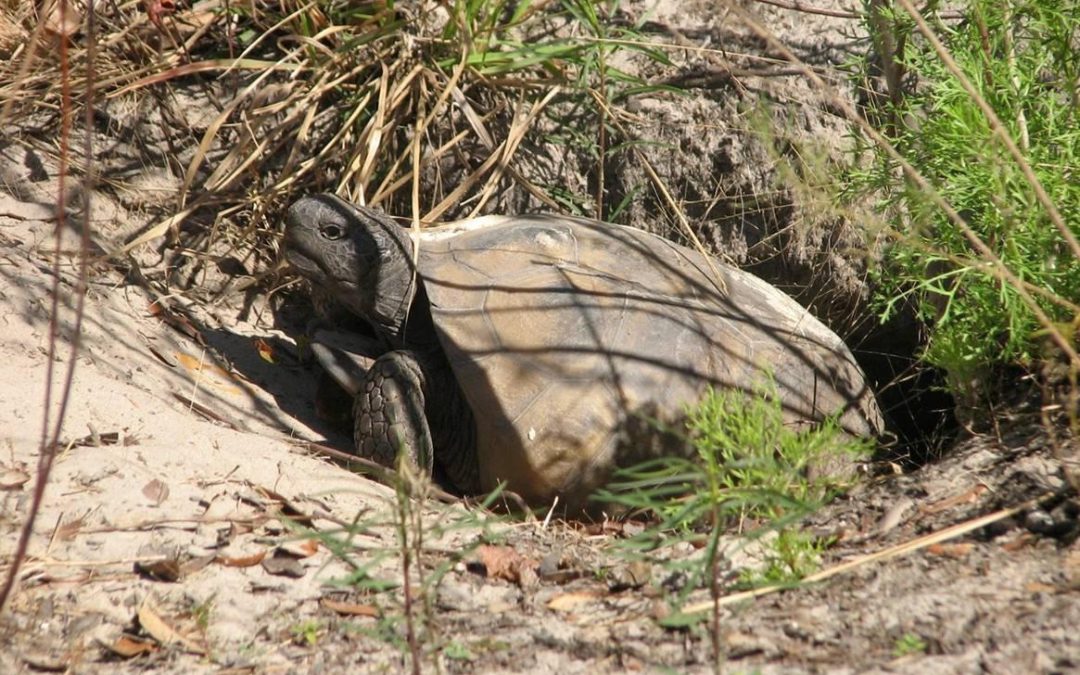
by Rick O'Connor | Jul 16, 2020
This blog will wrap up our series on Florida turtles for the Year of the Turtle (2020) – and we end with a good one – the gopher tortoise. We only have two true terrestrial species of turtles in Florida, and it does not get more terrestrial than the gopher tortoise.
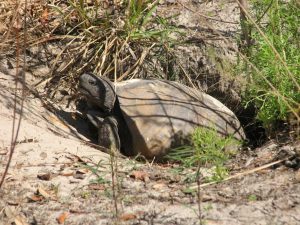
Gopher tortoises are long-lived, protected by their thick shells and deep burrows. Photo credit: Carrie Stevenson, UF IFAS Extension
“Gophers” (Gopherus polyphemus) are well known to many ole timers because they like the same type of habitat the earlier settlers did – high dry ground. They are indigenous to the southeast United States and prefer the open canopy of pine forest habitat. As a kid our home was on such a place in an area of Pensacola called Scenic Heights. Our house was on a “sand hill” that had pine and turkey oak trees. There were a variety of grasses and legumes growing everywhere and the soil was very dry and sandy. And we had gopher tortoise. The famous 18th century traveler/botanist, William Bartram, described this animal several times during his travels across the southeast as he crossed “sand hills” within the massive expanse of pine forest that were here at that time.
Though a forest, the longleaf pine forest of the southeast had a more open canopy allowing the growth of a variety of grasses to do well on the forest floor – as they did at my house. Tortoises are vegetarians, eating a variety of these grasses, flowers, and ground fruit. They like the young tender shoots of these plants and they were maintained those decades ago by natural wildfires started by lighting. The small fires would burn the large, tough plants down, providing the young tender shoots the tortoises prefer.
If you see a tortoise, you will notice the large square shaped shell and the elephant-like feet – definitely not a water turtle. They dig burrows in this sandy soil in which they can live during the hot days of summer and the cold days of winter. These burrows can be quite extensive – reaching a length of over 15 feet and a depth of up to 7 feet from the surface. Though the literature will tell you that they prefer dry sandy soils for digging, they have been found digging in the red clay of the southeast as well. However, these burrows are generally not as deep because the O2 levels decline and the CO2 concentrations increase significantly in clay soils. There is only one entrance to the burrow, and it has been said that gophers can dig down – but not up.

Gopher tortoises are nesting right now–be sure to observe from a distance!
It is generally one tortoise to a burrow, but some will dig a second burrow within their range as a “back-up” during pop up thunderstorms and such. It is not uncommon to find 2-3 tortoises sharing he entrance of a burrow during stressful moments – or during mating of course. The temperatures within are nice a cool during the summer – ranging from 60 – 72°F. This “air conditioned” hide away has become popular with many other creatures of the pine forest. Over 350 species of them have been known to share the burrow. Most of these are insects but a few vertebrates are known to call including – the gopher frog, mice, the endangered eastern indigo snake, and the eastern diamondback rattlesnake. Most of these animals use the burrow during extreme conditions – heavy rain, intense heat or cold, or during a forest fire. The rattlesnakes tend to sit near the entrance and so observers should beware of sticking their face or hand into the opening looking for a turtle. Many field workers will use a small hand mirror to look into the opening. Either you see the rattlesnake, or, the reflection of sunlight into the burrow will cause the snake to rattle – altering you they are there.
Terrestrial turtles produce fewer young than aquatic species. Gophers will typically produce 5-9 eggs once a year. The eggs are usually buried within the “apron” of the burrow – this is the field of sand discarded while digging. There is a projection from the anterior end of the plastron called a gular. This projection is much longer in males and can be used in jousting matches with other males. Males will also have a concave depression from the midpoint to the posterior end of the plastron. Though mating can occur any time of year – most activity is from May to July.
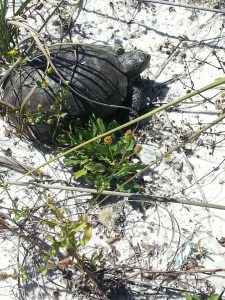
A terrestrial gopher tortoise crossing the sand on Pensacola Beach.
Photo: DJ Zemenick
These animals have declined across their range. They have the typical turtle egg raiders (raccoons, fox, skunks, and opossums) but now have threats from invasive species such as tegus and fire ants. Hatchlings and juveniles have soft shells and are easy targets. Coyotes have been seen hiding behind burrows flipping the emerging tortoise and then consuming it. However, man has been a problem as well.
Food was one problem, and apparently still is in some parts of the south. These animals were “noosed” from their burrows and cooked. During the depression era they were known as “Hoover’s Chicken”. As mentioned at the beginning – they live where we want to live. Construction crews come in and cover “entomb” them during development projects. It is now against Florida law and crews must relocate them.
In natural areas, the suppression of natural wildfires as altered the ecology enough that food for the gophers has become an issue. As they abandon their burrows seeking better spots, they are preyed upon, run over by cars, attacked by dogs, the list goes on. In recent years, an upper respiratory tract disease has proven to be common and deadly.
Today the animal is federally protected in Louisiana, Mississippi, and western Alabama. It is species of concern throughout its range and is a state threatened species in Florida. You cannot possess this animal but having one move into your yard is fine.
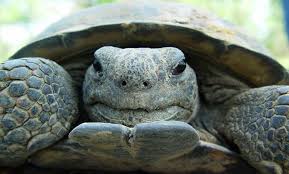
This gopher tortoise was found in a dune field; a place where they have historically been found.
Photo: DJ Zemenick
I hope you enjoyed this series on Florida turtles, during the YEAR OF THE TURTLE. You can find more blogs on other species by visiting the natural resource page of the Escambia County Extension website and type in which species you are looking for in the “what can we help you with?” search tool at the top of the page. https://sfyl.ifas.ufl.edu/escambia/?topic=natural-resources#county-feed.
I hope you are lucky enough to find all 25 species in the wild.
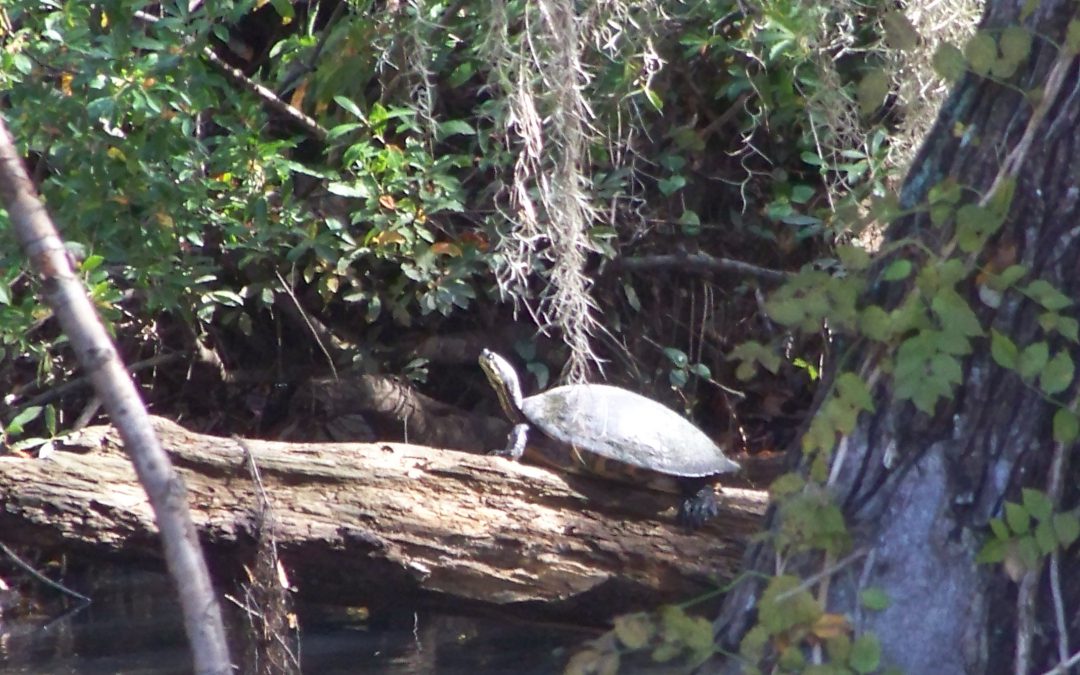
by Rick O'Connor | Jul 2, 2020
Cooters are one of the more commonly seen turtles when visiting a freshwater system. They are relatively large for a freshwater turtle (with a carapace about 13 inches long) and are often seen basking on logs, rocks, aerator pumps, you name it – and often in high numbers while doing so. They spook easy and usually leap into the water long before you reach them. But because of their beautiful smooth shells and large size, they can be seen from a distance – looking like wet rocks on a tree limb.
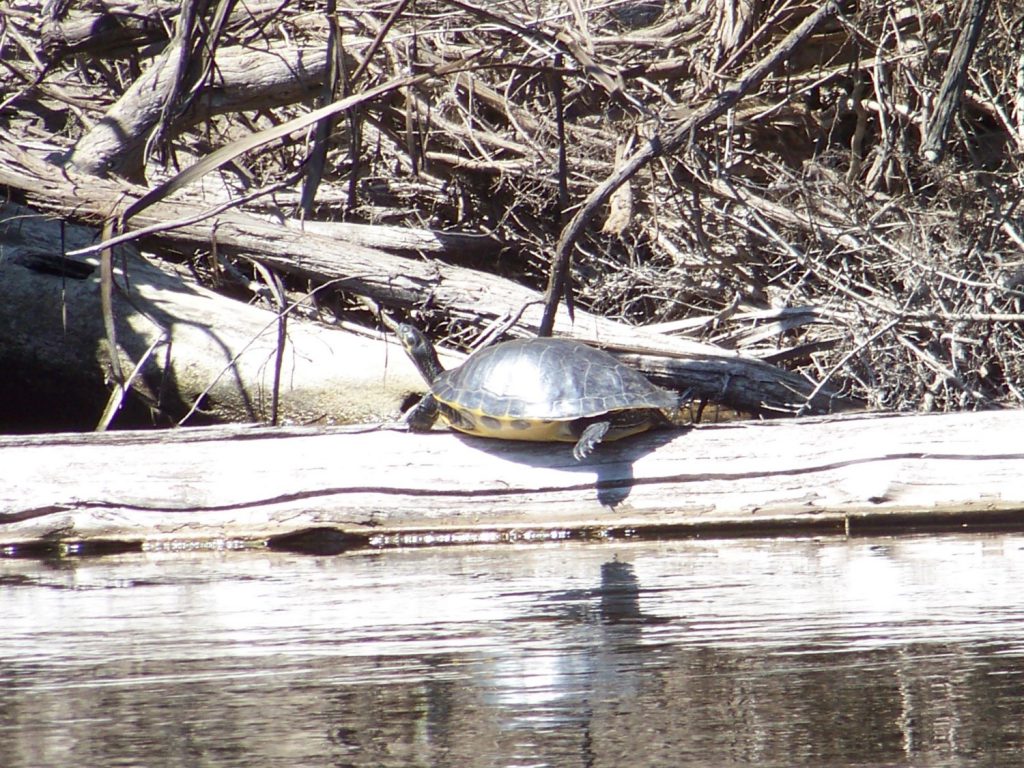
A “River Cooter” seen basking on a log in Blackwater River.
Photo: Molly O’Connor
They are in the genus Pseudemys (same as the Florida red-bellied turtles) and this genus is found throughout the southeastern United States. However, from there the breakdown of species becomes a bit challenging. There has been much debate how many species there really area, and how many are subspecies of those species. There are two distinct species for sure – the “River Cooter” (Pseudemys concinna) and the “Pond Cooter” (Pseudemys floridana). From here is gets a bit weird.
The “River Cooters” are just that – friends of rivers. They like those with a bit of a current, sand/gravel bottoms, basking spots, and grasses to eat. They have been found in estuaries, even with barnacles growing on them, so they have some tolerance for saltwater. River cooters can be distinguished from their “Pond Cooter” cousins in having a more aerodynamic shell (presumably for their habit of living in faster flowing rivers) with yellow-orange markings that form concentric rings on each scute (scale) of the carapace. Some of these seem to form a backwards “C”. Their plastron is yellow-orange but will have black markings along the margins of each scute.
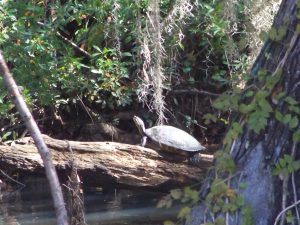
This river cooter is basking on a log on the heads waters of the Choctawhatchee River in Alabama.
Photo: Molly O’Connor
The “Suwannee Cooter” is believed to be a subspecies (Pseudemys concinna suwanniensis) found in tannic rivers from the Ochlockonee just west of Tallahassee south to the Tampa Bay region. It has only been found in rivers that flow into the Gulf of Mexico. A couple of records have been found in rivers flowing towards the Atlantic, but it is believed these were relocated by humans.
The “Eastern River Cooter” is found from the Ochlockonee River west to Mobile Bay – possibly as far as Louisiana. There has been a suggestion that the one west of Mobile Bay is the “Mobile Cooter” (Pseudemys concinna mobilensis) but the naming of this group, again, has been a bit crazy.
As mentioned, “Pond Cooters” are fans of slow-moving waters with muddy bottoms. Unlike river cooters, pond cooters will travel over land other than to lay eggs. Many of their “pond” selections dry up and they must find new habitat. Like river cooters, pond cooters feed on vegetation so aquatic plants are must and they also like to bask in the sun on logs with many cooters basking at once.
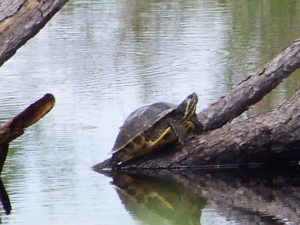
A pond cooter in a canal within the Gulf Islands National Seashore.
Photo: Molly O’Connor
Physically they differ from river cooters in having a slightly domed shell near the head end. The yellow markings are not concentric, but rather are in straight lines and their plastrons are an immaculate beautiful yellow – with no markings on the margins. They do however have black circles on the bottom margins of their carapace. These are usually round with a small yellow spot in the center – resembling an “o”.
There is believed to be two subspecies of this group. Pseudemys floridana floridiana (the “Florida Cooter”) and Pseudemys floridana peninuslaris (the “Peninsula Cooter”). Told you it was all weird. The Florida cooter is found in the Florida panhandle and the Peninsula Cooter has been found all the way to the Florida Keys – though it does not seem to be common in the Everglades.
Add to the quagmire of species identification – there is hybridization between not only the types of pond and river cooters – but BETWEEN the pond and river cooters. So, if you live in the eastern panhandle where all of these seem to converge – just call them “cooters”!
They have an interesting nesting habit. When the females approach an open sunny sandy spot, she will dig a hole to lay about 20 eggs, but she will also dig two “satellite” nests on either side – and maybe place an egg or two in there. It is quite understood why they do this, but they do. They also may come to the beach up to five times in one year to lay eggs.
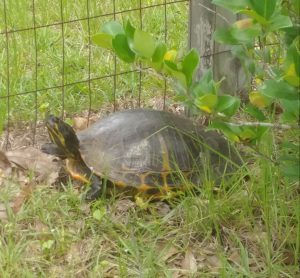
A pond cooter digging a nest on someone’s property.
Photo: Deb Mozert
Because of their high numbers and large size, this has been a favorite food item for humans for quite some time. Due to this, and the practice of shooting them off their basking spots, and alterations of river systems lower the habitat quality for the river cooters, their numbers have declined. The Suwannee Cooter in particular has been hard hit and is a species of concern. Due to this it no longer allowed to harvest them (or their eggs) from the wild. Because it is so hard to tell the Suwannee from other species/subspecies of cooters – ALL cooters are now protected by the Florida Fish and Wildlife Conservation Commission.
Another note – they do not eat fish. The young will eat worms and insects, but the adults are strictly herbivores. Many pond owners want to shoot them thinking they are eating the stocked fish by the landowner. They will not eat the fish – you are fine.
I think these are amazingly beautiful animals to see glimmering in the sunny on their basking logs as you explore our local rivers and wetlands. I hope you find them just as cool and appreciate them.
Resources:
Buhlman, K., T. Tuberville, W. Gibbons. 2008. Turtles of the Southeast. University of Georgia Press, Athens GA. 252 pp.
Florida Fish and Wildlife Conservation Commission. Freshwater Turtles https://myfwc.com/wildlifehabitats/wildlife/freshwater-turtles/.
Meylan, P.A. (Ed.). 2006. Biology and Conservation of Florida Turtles. Chelonian Research Monographs No.3, 376 pp.
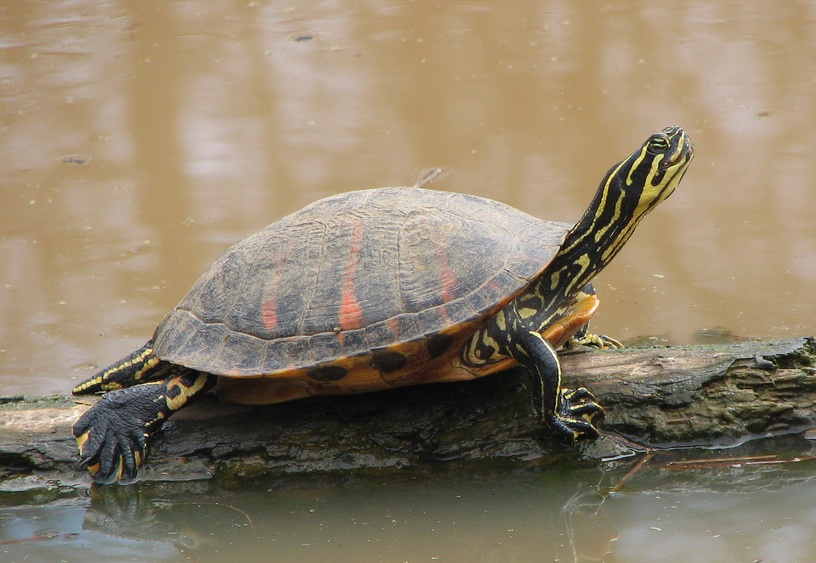
by Rick O'Connor | Jun 18, 2020
Cooters are common freshwater turtles throughout the state of Florida. There are currently three species listed: Pseudemys concinna – commonly known as the “river cooter”, Pseudemys floridana – referred to as the “Florida cooter”, and Pseudemys nelsoni – the “Florida red-bellied turtle”. It is this third species we will focus on in this article.
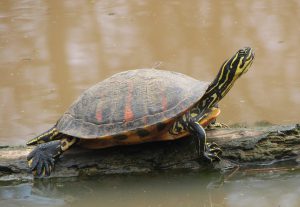
The wide red markings contrasting with the yellow striping on the body makes this a beautiful turtle.
Photo: Wikipedia
When you pick up a Florida red-bellied turtle you will see why it gets that name. The belly, or plastron, is a reddish-orange color. You will also see red coloration of the large broad stripes on the carapace and small red spots on the marginal scutes of the carapace. Contrasting this with the brilliant yellow stripes of the head and legs – this a beautiful turtle.
Like other cooters, they are big pond turtles as well – reaching carapace lengths up to 15 inches. They have high domed shells, compared to the other two cooters, and the shell is much thicker. This is probably due to the fact that the Florida red-bellied lives with the American alligator. They are known to even lay their eggs in an alligator nest! Other features that separate them from their cousins is the presence of yellow striping between the eyes resembling an “arrow”, and a deep notch in the upper lip.
The distribution of this turtle is interesting. They are definitely found, and are common, in the peninsular part of the state – ranging from the Okefenokee Swamp in southern Georgia to the Florida Everglades. Here they most frequently found in slow moving backwaters of rivers and springs, lakes, ponds, marshes, sinkholes, and even canals along highways. However, there have been verified reports of this animal in the Apalachicola River basin. Several have been found on St. Vincent island between Apalachicola and Port St. Joe. One was photographed within the city limits of Apalachicola and a few in the Dead Lake region of the Chipola River feeding into the Apalachicola. There is about 100 miles between the Suwannee and Apalachicola River systems – how did they make this trip?

The red coloration of the common Florida Red-bellied turtle.
Photo: Flickr
One idea is that someone brought them there a long time ago – and they have survived. A long time meaning prior to the 1950s. Another thought is that the historic range may have included much of the Florida panhandle before sea level changed. There is an Alabama Red-bellied turtle (Pseudemys alabamensis) that inhabits the marshes of the Mobile Bay delta. The habitat here is very similar to the marshes of the Everglades, and the Apalachicola region. The Alabama red-bellied has very similar characteristics to the Florida red-bellied (arrow stripes and notch in upper lip). There are no records of the Alabama Red-bellied in the delta of the Escambia River, and no record of either species in the Choctawhatchee delta. So, who knows??? To add to the story – one Florida Red-bellied was verified in the Wacissa River – which lies about halfway between the Suwannee and the Apalachicola rivers. Yep… interesting mystery.
Like other cooters, the females are larger than the males and the males have elongated fingernails on their forelimbs to entice the female’s interest in mating. These long fingernails are also found on the sliders (Trachemys). In Florida, the red-bellied appears to breed year-round. Even though nesting is typical of other turtles (spring and summer) they may lay eggs year-round as well.
The females will approach the beach multiple times during the nesting season and lay anywhere from 6-30 eggs in the nest. Sex determination of the young is determined by the temperature within the nest, warmer eggs become females. The Florida red-bellied has an unusual habit of laying some of their eggs in alligator nests. Though alligators can be considered a predator of this turtle, sneaking in and laying eggs will provide protection – for unlike turtles, alligators guard their nests from predators. It is believed the thicker shell of the Florida red-bellied is to protect it from this possible adversary.
That said, they do have their predators. Like all young turtles there are a variety of birds, fish, mammals, and reptiles that feed on them. Red-bellies are plant eaters – feeding on a variety of aquatic plants including the invasive water hyacinth and hydrilla.
These are common basking turtles throughout much of peninsular Florida and visitors should easily get a glimpse of them while they are here. How far into the Florida panhandle they range is still a mystery – but an interesting one. I hope one day you get to see this beautiful turtle.
References
Buhlmann, K., T. Tuberville, W. Gibbons. 2008. Turtles of the Southeast. University of Georgia press, Athens GA. 251 pp.
Meylan, P.A. (Ed.) 2006. Biology and Conservation of Florida Turtles. Chelonian Research Monographs No.3. 376pp.






















